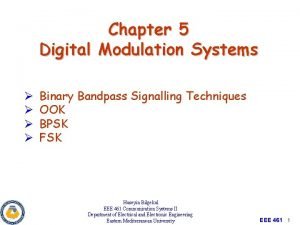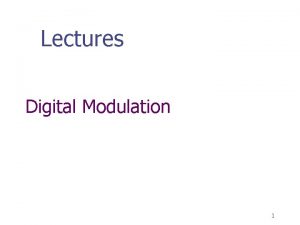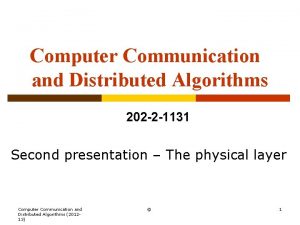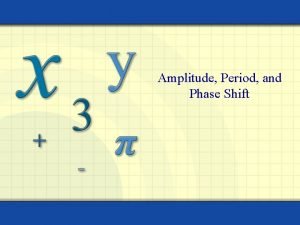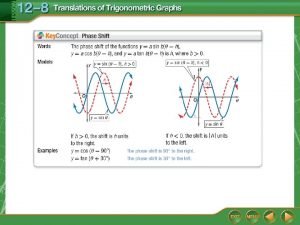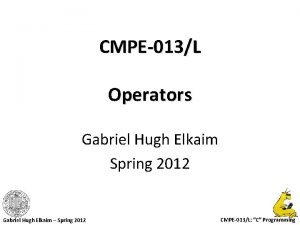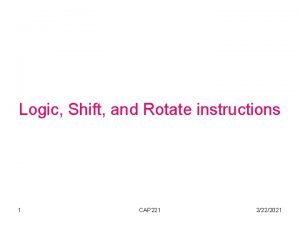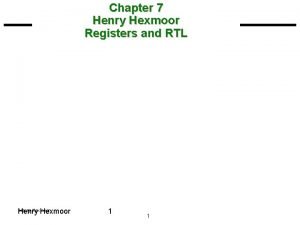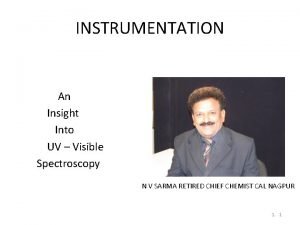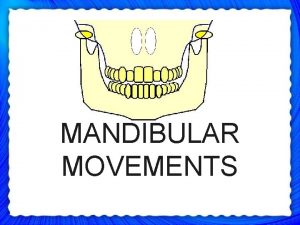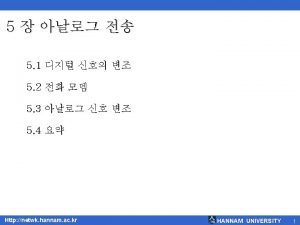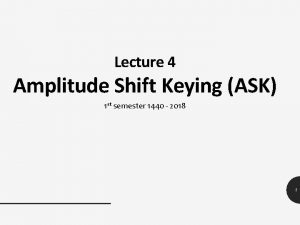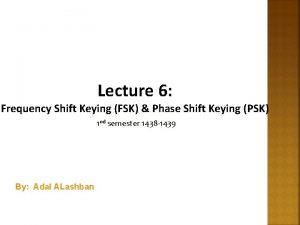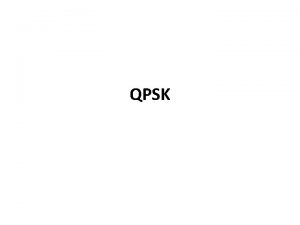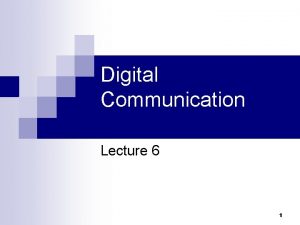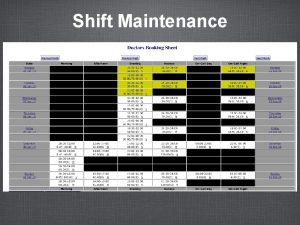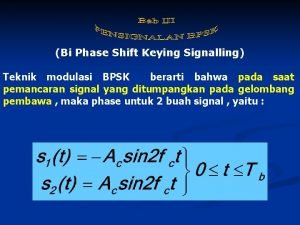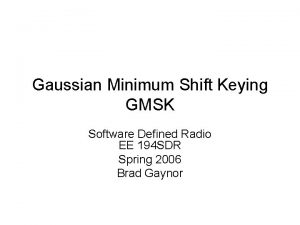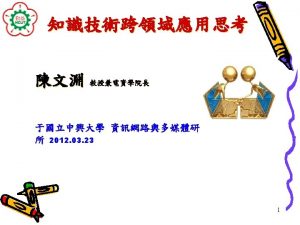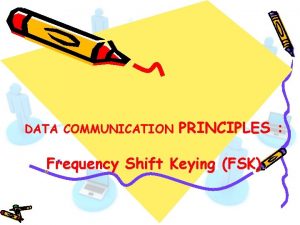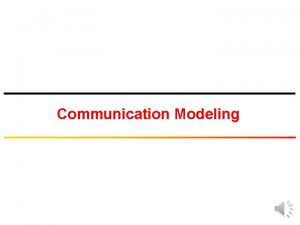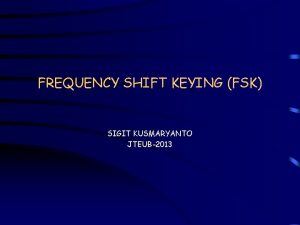Lecture 5 Amplitude Shift Keying ASK 1 nd



















- Slides: 19

Lecture 5: Amplitude Shift Keying (ASK) 1 nd semester 1438 -1439 By: Adal ALashban 1

Outline - Analog conversion. - Modulation. - Why we need digital modulation? - Modulation of digital data. - Types of digital-to-analog conversion. - Aspects of digital-to-analog conversion. - Bit rate and baud rate. - Amplitude shift keying. 2

Introduction - Digital data, more specifically, the binary data changes the properties of the carrier signal. 1 - Amplitude 2 - Frequency 3 - Phase 3

Analog Conversion - Digital-to-analog: conversion is the process of changing one of the characteristics of an analog signal based on the information in digital data (0 or 1). - Analog-to-analog: low pass analog signal to band pass analog signal. 4

Modulation - Definition: transforming the information to be transmitted into a format suitable for the used medium. - The signals are transmitted as a sine wave which has three parameters: amplitude, frequency and phase shift. - These parameters can be varied in accordance with data or another modulating signal. - Two types of modulation: 1 - Digital modulation: digital data (0, 1) is translated into an analog signal (baseband signal). 2 - Analog modulation: the center frequency of the baseband signal generated by digital modulation is shifted up to the radio carrier.

Why we Need Digital Modulation? - Digital modulation is required if digital data has to be transmitted over a medium that only allows analog transmission (modems in wired networks). - Digital signals, i. e. 0/1, can be sent over wires using voltages. - Wireless must use analogue sine waves. - This translation is performed by digital modulation: - Digital data is translated into an analog signal (baseband). - Shift Keying is the translation process. - Amplitude, Freq. , Phase Shift Keying (ASK/FSK/PSK).

Modulation of Digital Data Digital /Analog converter Analog /Digital converter 7

Types of Digital to Analog Conversion - A sine wave is represented by three characteristics: Amplitude, Frequency and Phase. - We can change one of these digital data. characteristics to represent 8

Aspects of Digital to Analog Conversion - Carrier Signal or carrier frequency: - A high frequency signal that acts as a basis for the information signal. - Digital information then modulates the carrier signal by modifying one or more of its characteristics (Amplitude, frequency or phase). - This kind of modification is called modulation or shift keying, and the information signal is called modulated signal. 9

Carrier Signal ASK modulated signal

Bit Rate and Baud Rate - Bit rate: is the number of bits per second (bps ). - Baud rate (Nbaud): is the number of signal units per second (baud/s). A signal unit (one baud) is composed of 1 or more bits

Amplitude Shift Keying (ASK) - In ASK the amplitude of the carrier signal is varied to represent binary 1 or 0. - Both frequency and phase remain constant while the amplitude changes. - The peak amplitude of the signal during each bit duration is constant, and its value depends on the bit (0 or 1). ASK-Modulated signal

Digital Modulation; Amplitude Shift Keying (ASK) - Amplitude Shift Keying (ASK): - 0 and 1 represented by different amplitudes. i. e. a basic sine wave. - Problem: susceptible to interference. - Constant amplitude is hard to achieve. - ASK is used for optical transmissions such as infra-red and fiber (simple + high performance). - In optical light on = 1 light off = 0

Binary ASK (BASK) or On Off Keying (OOK) - Although we can have several levels (kinds) of signal elements, each with a different amplitude, ASK is normally implemented using only two levels. This is referred to as binary amplitude shift keying. - We can think of a carrier signal as an ON or OFF switch. In the modulated signal, logic 0 is represented by the absence of a carrier, thus giving OFF/ON keying operation and hence the name given OOK.

On Off Keying (OOK)

ASK Generation

Demodulator or Detector - The demodulator determines the amplitude of the received signal and maps it back to the symbol it represents, thus recovering the original data.

Pros and Cons - Pros: ASK transmitter and receiver are simple to design. ASK needs less bandwidth than FSK. - Cons: ASK transmission can be easily corrupted by noise. - Application: Early telephone modem (AFSK). ASK is used to transmit digital data over optical fiber.

Any Questions ?
 Phase shift keying
Phase shift keying Binary phase shift keying
Binary phase shift keying Probability symbol
Probability symbol Frequency shift keying modulation
Frequency shift keying modulation Amplitude period phase shift
Amplitude period phase shift Amplitude period phase shift
Amplitude period phase shift What are the 7 proper keyboarding techniques?
What are the 7 proper keyboarding techniques? Master keying chart
Master keying chart Ask ask
Ask ask Pendleton's feedback model
Pendleton's feedback model Difference between arithmetic shift and logical shift
Difference between arithmetic shift and logical shift Verilog
Verilog Bathochromic shift and hypsochromic shift
Bathochromic shift and hypsochromic shift Difference between arithmetic shift and logical shift
Difference between arithmetic shift and logical shift Cap 221
Cap 221 Difference between arithmetic shift and logical shift
Difference between arithmetic shift and logical shift Bathochromic shift and hypsochromic shift
Bathochromic shift and hypsochromic shift Auxochrome
Auxochrome Horizontal plane border movement
Horizontal plane border movement 01:640:244 lecture notes - lecture 15: plat, idah, farad
01:640:244 lecture notes - lecture 15: plat, idah, farad

